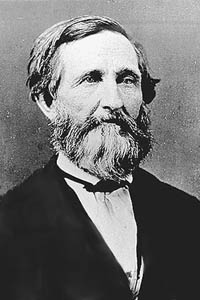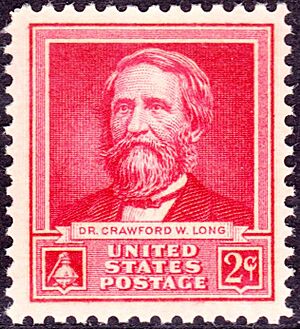Crawford Long facts for kids
Quick facts for kids
Crawford Long
|
|
|---|---|

Crawford Long
|
|
| Born | November 1, 1815 Danielsville, Georgia
|
| Died | June 16, 1878 (aged 62) Athens, Georgia
|
| Nationality | United States |
| Alma mater | University of Georgia University of Pennsylvania |
| Known for | Anesthesia induced by ether |
| Scientific career | |
| Fields | Medicine |
Crawford Williamson Long (born November 1, 1815 – died June 16, 1878) was an American doctor and pharmacist. He is famous for being the first person to use a special gas called ether to make patients sleep during surgery. This gas helped stop pain and is known as an anesthetic.
Contents
Early Life and Education
Crawford Long was born in Danielsville, Georgia, on November 1, 1815. His parents were James and Elizabeth Long. His father was a state senator, a merchant, and a farmer. He named his son after his good friend, William H. Crawford, a Georgia statesman.
By the time he was 14, Crawford had finished at the local school. He then went to the University of Georgia in Athens. There, he shared a room with Alexander Stephens, who later became the Vice President of the Confederate States of America during the American Civil War. In 1835, Long earned his A.M. degree.
He started studying at Transylvania College in Kentucky in 1836. Here, he learned from Benjamin Dudley, a respected surgeon. Long watched and took part in many surgeries. He saw how painful operations were without anything to stop the pain. After one year, Long moved to the University of Pennsylvania in Philadelphia. This university had some of the newest medical technology at the time. He earned his M.D. degree in 1839.
Discovering Anesthesia
After working for 18 months in New York, Long went back to Georgia. In 1841, he started a medical practice in a small town called Jefferson. He noticed that a gas called ether had similar effects to another gas, nitrous oxide, which had been described by Humphry Davy in 1800.
On March 30, 1842, Long used ether for the first time during surgery. He removed a tumor from the neck of a patient named James M. Venable. Long simply put ether on a towel and had the patient breathe it in. The patient felt no pain.
Over the next few years, Long used this method for many other surgeries. He even used it when helping women give birth. He removed a second tumor from Venable and used ether for amputation surgeries too.
Sharing His Discovery
Even though Long kept using ether, he did not immediately tell the public about his findings. He wanted to be sure of his results. The details of his work were finally published in 1849. This happened in a magazine called The Southern Medical and Surgical Journal. You can find an original copy of this publication at the U.S. National Library of Medicine.
On October 16, 1846, another doctor named William T. G. Morton publicly showed how ether could be used for anesthesia. He did this at the Massachusetts General Hospital in Boston. Morton did not know about Long's earlier work. When Morton's work was published, Long realized he needed to share his own discovery.
Long had told some of his doctor friends about his method. They had also used ether in their practices. But Morton is often given credit for the first public demonstration of ether anesthesia. After Morton's articles came out, Long started writing down all the details of his experiments. He collected statements from his patients and had their letters officially recorded. He reported his findings to the Medical College of Georgia in 1849.
Long explained that he waited to publish because he wanted to be sure of his findings. He also wanted to see if anyone else would claim to have discovered anesthesia before him. He wrote that no one had published about using ether to prevent pain in surgery as early as March 1842.
In 1854, Long asked a U.S. Senator, William Crosby Dawson, to tell Congress about his claims. Even with all his efforts and proof, he was not fully recognized for his discovery during his lifetime.
Family and Later Life
Crawford Long married Caroline Swain in 1842. They had 12 children together, but only seven lived to be adults. The family moved to Atlanta in 1850, and then to Athens in 1851. This move brought them closer to friends and family. In Athens, Long and his brother Robert opened a private medical practice and pharmacy.
During the American Civil War, Long joined a local militia group. However, he was never called to fight. Instead, he worked as a surgeon in Athens, helping soldiers from both sides of the war.
Crawford Long died on June 16, 1878, from a stroke. This happened shortly after he helped deliver a baby. He is buried with his wife in Oconee Hill Cemetery in Athens, Georgia. Long believed his job was a "ministry from God." He said his main goal was "to do good and leave the world better by his labors."
Long's Legacy
Crawford Long was the first doctor to use anesthesia in childbirth. In 1845, he had his wife breathe in ether while she was giving birth. For a long time, his method of using inhaled anesthesia was common in childbirth.
In 1849, Long announced his discovery in a small local magazine. But he did not get much attention until Marion Sims, a surgeon from New York, wrote a major article about Long's work. Today, most experts agree that Long performed the first successful surgery using anesthesia. He used ether on seven patients, and none of them felt pain during their operations. This was several years before Morton's public demonstration in 1846.
Long's delay in publishing his findings was due to two main reasons. First, he wanted to confirm his results many times. Second, he wanted to see if any other doctor would come forward to challenge Morton's claims. He also wanted to see if someone had discovered anesthesia even before him.
After reading about Morton's demonstration, Long asked his patients to write sworn statements to prove his discovery. Long almost certainly discovered the pain-dulling effects of ether before Morton showed it to the public. However, several other men also claimed credit for discovering surgical anesthesia. These men included Morton, Horace Wells, and Charles J. Jackson. They competed for a reward of $200,000 from the U.S. Congress.
In 1879, a year after Long's death, the National Eclectic Medical Association officially declared him the discoverer of anesthesia. "Doctors Day" is celebrated every year on March 30 to remember Long's important contributions.
Many places and things are named after Crawford Long:
- In April 1912, the University of Pennsylvania honored him with a bronze medal.
- On August 14, 1920, a new county in Georgia was created and named Long County in his honor. The main town in the county is Ludowici.
- The Crawford W. Long Hospital in downtown Atlanta was named after him in 1931. In 2009, it was renamed "Emory University Hospital Midtown," but his name is still on outside monuments.
- Long was honored on U.S. postage stamps in 1940 and with a postcard in 1978.
- The Crawford W. Long Museum in downtown Jefferson, Georgia opened in 1957. A monument to Long was also put up in Jefferson in 1910.
- A statue of Long stands in the United States Capitol. It is one of two statues representing Georgia in the National Statuary Hall Collection.
- Crawford Long Middle School in Atlanta, Georgia, is also named after him.
- Long's childhood home was added to the National Register of Historic Places in 1977. It is on Crawford W. Long Street in Danielsville, Georgia.
See also
 In Spanish: Crawford Williamson Long para niños
In Spanish: Crawford Williamson Long para niños


